Hey Buddy
Hazard to Others
  
Posts: 426
Registered: 3-11-2020
Location: Bushwhacker Country
Member Is Offline
|
|
Guanidium Explosive Complexes
This is a thread grown off of B(a)Ps aminoguanidiumdiperchlorate thread. It occurred to me that there has been suggestion buried in SM threads that
there should be regular old guanidium complex explosive salts. I found some of these comments while searching for information on the topic. However
there are no threads about attempts or successes to make them.
According to PHILOU Zrealone in old threads, prospective salts may include tris perchlorate salts particularly in Co and Ni.
So far in the realm of perchlorate guanidium complexes, I have only determined how to freebase the guanidine from the nitrate salt. To do this, I
heated a solution of GuNO3 in denatured alcohol then added a molar equivalent of NaOH while stirring at around 68 C. Then stirred it for five minutes.
The freed guanidine separates to the bottom upon settling and is poured off through a filter. Guanidine free base is one of the most soluble things
Ive seen. It disappears if water even touches it.
B(a)P seemed to recommend using the German patent EP2450330A2 from aminoguanidium perchlorate and perhaps trying some of those techniques. I believe
for the patent procedure they are using aqueous medium and several routes. The simplest route AAV1 example 2.1- appears to be Metal perchlorate salt
mixed with guanidium ligand in water and boiled for 10 minutes then left to stand for 4 hours and the crystals filtered and washed with ethanol.
Another simple option would be if the amine complex is desired, basically use the method of TACP and add guanidium. I will try this tonight.
I have been trying to do a metathesis switcheroo reaction (technical term) of simple metal perchlorates to try out different metals but apparently Im
not smart enough to do that because I tried a reaction between a homemade NiCl2 and KClO4 and it doesnt seem to produce a KCl precipitate as
anticipated by adding ethanol, which if it worked, would mean that NiClo4 hexahydrate was in solution and I would just need to evaporate it. But it
didnt seem like much precipitated from adding EtOH so Im not sure if that worked. If anyone has a good procedure theyve used to prepare metal
perchlorates please teach me if you would. I have NH4ClO4 and KClO4 in hand. I dont have any HClO4 and have never prepared it so I'm unfamiliar with
that, but if need be I will learn to prepare HClO4. The patent proecedure appear to be possible using only salts.
I also tried out of frustration just putting NH4OH in a jar with some CoCO3 and NH4ClO4 and guanidine free base. Then I warmed it to around 60 C on a
hot plate. Each addition appeared to change the color so that seems promising. Im waiting to se if anything crystallizes from it.
I figured I would make this thread to track any progress or failure on potential Gu complex salts
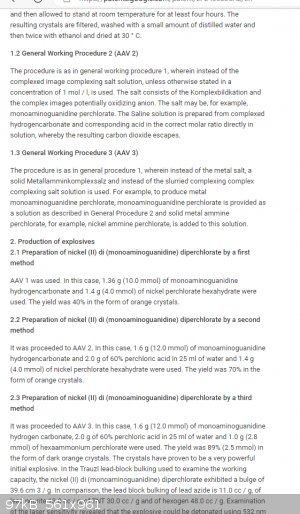
|
|
|
Hey Buddy
Hazard to Others
  
Posts: 426
Registered: 3-11-2020
Location: Bushwhacker Country
Member Is Offline
|
|
update: Co NH3 complex has been sitting 2 hours and has pink rectangular crystals forming in filtrate. The aminoguanium cobalt perchlorate complex
analogue from the patent is purportedly explosive unconfined and is a liquid/paste phase form. I will dry and test tonight and if it is energetic I
will make a short vid with procedure.
|
|
|
Laboratory of Liptakov
International Hazard
    
Posts: 1382
Registered: 2-9-2014
Location: Technion Haifa
Member Is Offline
Mood: old jew
|
|
Confirmed method preparation HClO4 .....
https://www.youtube.com/watch?v=KXpGlgj9_uw&t=23s
Development of primarily - secondary substances CHP (2015) Lithex (2022) Brightelite (2023) Nitrocelite and KC primer (2024)
|
|
|
Hey Buddy
Hazard to Others
  
Posts: 426
Registered: 3-11-2020
Location: Bushwhacker Country
Member Is Offline
|
|
LL thanks for that perchloric acid method. Has anyone ever had luck with metathesis routes to metal perchlorates?
update: Co NH3 complex was filtered, crystals scraped out with popsicle stick. Popsicle stick put over candle wet, shoots out big sparks. Doesn't
detonate. Not sure how loud it was if there was any popping because I had ear muffs on. I should rather say it doesnt detonate at least while its wet,
and in popsicle stick surface amounts, which could only be a few mg. but even wet its faster and more aggressive than TACP burning.
Does Ni AGu (ClO4)2 detonate while wet? The burning of this Co complex reminded me a lot of the video Ive seen of Cu AGu ClO4 when it doesnt detonate
but burns in open.
I have a gram or two drying now at 45 C. will test foil confinement tonight if it dries. TACP version of Gu complex is sitting in solution now, going
to boil 5 minutes then allow cooling. Co complex is still dropping pink crystals in filtered solution at ambient temp. So maybe for Cu version I will
try dropping temp in freezer to promote precipitation crop?
Does anyone know what the theoretical complexes would be for usual metals? Cu, Ni, Zn, Co, Ag? I have been using LLs jar method for TACP and have been
adding NH4CLO4 in NH4OH so the cobalt and copper will be amine complexes I havent thought of any non-amine complexes, but I guess without perchloric
acid I could try a K double salt with KClO4? and I added 3x excess molar CLO4 to Gu incase it is three perchlorates per complex, but im flying blind.
No idea what the theoretical Gu complexes would be for correct molar masses.
I have some vanadium pentoxide i could try later if any of these actually start detonating like a primary when dry.
[Edited on 3-12-2022 by Hey Buddy]
|
|
|
Hey Buddy
Hazard to Others
  
Posts: 426
Registered: 3-11-2020
Location: Bushwhacker Country
Member Is Offline
|
|
The Co complex in drying started as a pink rock candy looking pile of crystals very pretty. now on drying it is losing some color and turning brown in
some areas. not sure if decomp or foreign metal contamination. I used CoCO3 bought from ceramic supply store. Crystals are still dropping out of the
filtrate on Co.
Cu complex solution began dropping out crystals without any heat applied. I interrupted it heating it to <boil on a hot plate, for 5 min then took
it off to cool to ambient then it will go in freezer. picture is solution after crystals got stirred back in. It has a violet tint to it.
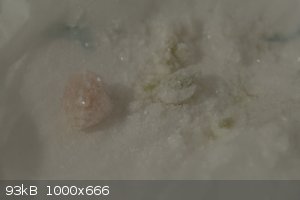 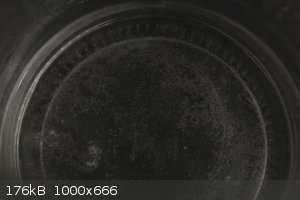 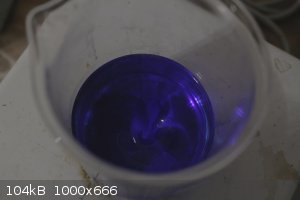
[Edited on 3-12-2022 by Hey Buddy]
|
|
|
Hey Buddy
Hazard to Others
  
Posts: 426
Registered: 3-11-2020
Location: Bushwhacker Country
Member Is Offline
|
|
How stupid would it be to drop acetylene infused acetone into one of these mother liquors?
update: Co complex on drying has shifted color from pink to clear to brown and now it is an emerald green or turquoise. I suppose the color changes
are not contamination but just the compound. Oxidizing perhaps?
[Edited on 3-12-2022 by Hey Buddy]
Update: This complex burns weird has funny color changes and is high temp in decomposition. It seemed like after mostly drying it burned less
energetically than an hour before. It seemed like it could be promising at first but I dont like anything about it. --The Cu complex lost its crystals
in freezer so apparently I need to attempt again and not heat it this time, as there were certainly crystals forming while the solution was sitting at
ambient.
Things learned:
-Complexes are definitely forming from guanidines but the Co amine salt seems pretty useless and doesnt detonate burning unconfined nor burned
confined.
-free based guanidine has been in drying for 24 Hrs now and shows no signs of decomposition nor changes in a heated covered pan. So guanidine may be a
viable moiety for complexing a primary type compound.
-free based guanidine goes into solution very fast, much faster than ammonium perchlorate salt.
-Cu Amine complex with Gu is not crystallizing in a straight forward way like Co.
Any ideas for combinations that would be more energetic? Different ratios of reactants perhaps?
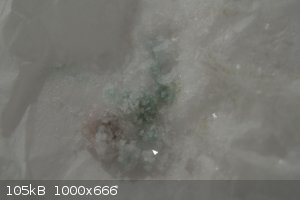 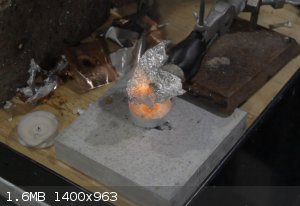
[Edited on 3-12-2022 by Hey Buddy]
[Edited on 3-12-2022 by Hey Buddy]
[Edited on 3-12-2022 by Hey Buddy]
|
|
|
Hey Buddy
Hazard to Others
  
Posts: 426
Registered: 3-11-2020
Location: Bushwhacker Country
Member Is Offline
|
|
I found a patent US2929698A regarding diaminoguanidium salt explosives, in it states,
"While it is recognized that the acid derivatives of guanidine have been considered previously for use in explosives mixtures, we have found that they
do not possess the favorable properties of the diaminoguanidine salts"
So it's not looking good for guanidine yet. But the same patent also states " We have discovered that the sensitivity of the diaminoguanadine salts is
such that they can be readily brought to complete high order detonation by a priming charge of mercury fulminate, Whereas the corresponding salts of
guanidine cannot be so detsame conditions."
But it's known that simple guanidine perchlorate is more sensitive than picric acid and has a near TNT detonation velocity. So it would seem the
patent is referring to traditional guanidine salts, not including the perchlorate. Maybe just the nitrate. Guanidine doesn't have very many
cheerleaders. Except me- go-go guanidine pechlorate complexes BTFU!
...Trying vanadium
[Edited on 3-12-2022 by Hey Buddy]
|
|
|
underground
National Hazard
   
Posts: 702
Registered: 10-10-2013
Location: Europe
Member Is Offline
|
|
Maybe nickel , zink, lead
|
|
|
Hey Buddy
Hazard to Others
  
Posts: 426
Registered: 3-11-2020
Location: Bushwhacker Country
Member Is Offline
|
|
Vanadium was not energetic at all. Suspiciously not energetic. It lost all color around 70 C during boiling and became mostly clear, with clear/white
crystals on cooling. It didnt burn at all over flame. Ive learned that guanidine has an mp of only 50 C. I believe aminoguanidine is higher. The
general procedure boiling may not be applicable to guanidine complexes. I suspect that on boiling the solution, it is preventing target complexation.
The use of ammines could also be a problem. Im going to take a different approach and make the aminoguanidine perchlorate complexes with known
properties, then work backwards substituting guanidine so that successful method can perhaps be found in parallel through guanidine, with less
variables.
|
|
|
Laboratory of Liptakov
International Hazard
    
Posts: 1382
Registered: 2-9-2014
Location: Technion Haifa
Member Is Offline
Mood: old jew
|
|
Just a note: TACP + 10% guanidine nitrate creates almost as explosive a substance as TACP + hexamine 6%. It must be added that TACP has an oxygen
balance of + 14.5. So the addition of almost any fuel increases its performance and DDT reliability. Aluminium, Magnesium, Magnalium, nitrocellulose,
ethylene glycol, diethylene glycol. But I'm getting off topic.
Development of primarily - secondary substances CHP (2015) Lithex (2022) Brightelite (2023) Nitrocelite and KC primer (2024)
|
|
|
Hey Buddy
Hazard to Others
  
Posts: 426
Registered: 3-11-2020
Location: Bushwhacker Country
Member Is Offline
|
|
Update: Earlier a failed attempt was made to crystallize product from TACP procedure adding guanidine as a ligand. The procedure was informed by the
known aminoguanidine ligand patent which boils the reaction solution. This was attempted and no precipitate formed even after overnight standing.
Guanidine ligand version of TACP *may* crystallize as very small crystals. I have repeated procedure but this time I did not heat the reaction
solution, simply stirred at 35C. Before adding guanidine free base, I prepared TACP with copper foil, 10% NH4OH and NH4ClO4 by adding reagents to jar
with vented lid. Then let the TACP reaction proceed at 35 C for a day and a half. Then guanidine was added to the reaction solution and when it
dissolved it made the solution slightly darker and slightly more opaque. I let the guanidine stay in the solution for another 24hrs at 35C. Then the
Jar was cooled in the freezer and after about an hour and half smalll crystals collected at the bottom of the jar. There is a good chance this is
complexed with guanidine moiety. Ive done the TACP procedure quite a few times and these crystals are smaller than what I normally see when preparing
TACP. The sample is drying at 35C. Hopefully it is energetic. I have not had luck with nickel compound preparation and have not tried lead. I do have
lead though but I wasnt sure of procedure to make it soluble. Nickel is so unreactive I have had no luck dissolving it in NH4OH soaking in solution
for days. I attempted to prepare nickel carbonate by dissolving nickel in Hcl making NiCl2 and then attempted to add excess bicarb. It made a mess.
And it turned brown after a day.
I have built a small electrolytic membrane reduction cell to reduce out some aminoguanidine, it is running tonight to reduce some nitroguanidine but
my power supply broke so I ordered a new bench supply and rigged up a car charger to the cell. It's running a little low power about 1/10 of the
recommended current but hopefully it is still enough. I will know by the morning if the NQ dissolves into the catholyte.-- Speaking of energetic
nickel complexes, I saw energetic heretic on youtube used nickel acetate which seemed like a sensible route to introduce nickel ions in light of the
trouble with the CO3. I tried a nickel acetate electro production cell and it didnt work without salt but I scrapped the idea thinking that
introducing sodium chloride would put other ions in solution. I do have glacial acetic acid but Im not sure if nickel will dissolve in it or not. It
is frozen now so I havent tried to thaw it as Im unsure if it would dissolve nickel.
[Edited on 5-12-2022 by Hey Buddy]
UPDATE: NEXT MORNING: It's not energetic. Certainly no initiating explosive
[Edited on 5-12-2022 by Hey Buddy]
|
|
|
Laboratory of Liptakov
International Hazard
    
Posts: 1382
Registered: 2-9-2014
Location: Technion Haifa
Member Is Offline
Mood: old jew
|
|
High yield of TACP is prepared in a Liptakov converter. In a rotating container. 37 g of dry TACP can be obtained from 30 g of NH4ClO4. A condition
for a high yield is a low reaction temperature of 10 - 20 C and a high concentration of NH4OH. Preferably 25% aq. A high concentration of hydroxide
guarantees high reactivity and high precipitation of crystals. That is, the yield. The low temperature of the reaction slows down the reaction, but
prevents the formation of unwanted oxides. Such as copper oxychloride. Under the mentioned conditions, it is also possible to prepare nickel
perchlorate diamine. (DANiP) Made of nickel sheet. However, with a yield of only 10g. Compared to TACP with a yield between 30 - 37g.
Last measured conditions for TACP preparation: 4 hours rotating converter 120 rpm, 14g copper wire dia. 1.4 mm, 30g NH4ClO4, 90g NH4OH 25% aq, 10g
H2O2 30%aq. Run temperature 15 C. H2O2 increases the starting rate of the reaction (increased copper oxidation) and overall contributes to a high
yield. The resulting yield was 37.5 g of dry TACP. Filtered after cooling on zero by 2 hours.
Development of primarily - secondary substances CHP (2015) Lithex (2022) Brightelite (2023) Nitrocelite and KC primer (2024)
|
|
|
Hey Buddy
Hazard to Others
  
Posts: 426
Registered: 3-11-2020
Location: Bushwhacker Country
Member Is Offline
|
|
I've been thinking about this all day. Guanidine should complex easily and a metal perchlorate complex should be pretty reactive. I just don't think
the guanidine is getting into complex. Generally I do large crystal TACP and break it down, so I assumed guanidine was complexing as a smaller crystal
but the more I think it over I'm not convinced it is successfully complexing. ANQ primary explosives are made with heated water as solvent and AGu
complexes also use heated water as the solvent so this seems like the obvious choice but I cant help but wonder if the reaction medium should be other
than water. I hoped coordination would be straight forward and effective with obvious increased reactivity of a Gu ClO4 complex. It's proving either
difficult in coordination more so than its brother ligand analogues or it is in fact coordinating but there isnt much of a difference from TACP
deflagration (seems like a sluggish TACP).
Perhaps eliminating amine in coordination and simply using only target metal perchlorates would give better revealed results. I just cant believe the
guanidine is successfully coordinating.
|
|
|
Hey Buddy
Hazard to Others
  
Posts: 426
Registered: 3-11-2020
Location: Bushwhacker Country
Member Is Offline
|
|
Tried something different. CuSO4, NH4CLO4, Guanidine brought to boil for 5 min then cooled overnight. Gigantic christmas tree crystals in bottom.
NH4SO4 is 70g/100ml soluble so I would reckon they have to be complex. The color is unexpected though, I thought it would be blue. I will add pic
later...
|
|
|
Hey Buddy
Hazard to Others
  
Posts: 426
Registered: 3-11-2020
Location: Bushwhacker Country
Member Is Offline
|
|
Had to go to the city. Crystals looked just the same. Drying out now. Seems promising but I'm not holding my breath. The fat lady must sing.
Is turquoise green a Cu+1 rather than the typical blue +2 color of a Cu(II)SO4 sulfate? This is result of CuSO4*5H2O + NH4ClO4 + Guanidine free base.
NH4SO4 should be in solution.
edit: i think CuClO4 is also +2 hence the deep blue tint of TACP
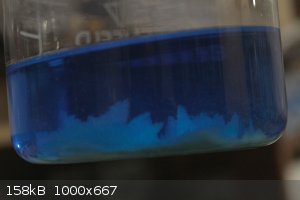 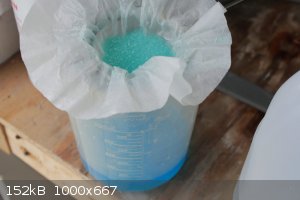 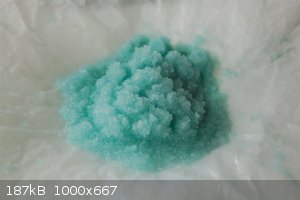
[Edited on 6-12-2022 by Hey Buddy]
edit: i think then a +1 lead complex is then possible. I suppose I will make some metal sulfates because this worked easily and clean
[Edited on 6-12-2022 by Hey Buddy]
|
|
|
Hey Buddy
Hazard to Others
  
Posts: 426
Registered: 3-11-2020
Location: Bushwhacker Country
Member Is Offline
|
|
Nothing special with this turquoise compound burning.
I also tried the same procedure with NQ. It seemed to recrystallize out simple NQ, so I redissolved it and added molar equivalent of glycine at boil.
It turned more purple immediately. It recrystallized similar to NQ but with blue color and it burns with a bright blue flame under a blow torch and
every so often the rate of burn speed increases but it seems like the change in burn is intermittent like a non homogenous mix. But the blue color is
inside the crystals. When I first saw crystals I fished thm out thinking excess NQ. Placed on napkin. Blue fluid wicked out, crystals still maintain a
blue color, probably trapped inside the crystal.
|
|
|
Laboratory of Liptakov
International Hazard
    
Posts: 1382
Registered: 2-9-2014
Location: Technion Haifa
Member Is Offline
Mood: old jew
|
|
Important is hammer test. More important than any burning on foil. Any way, interesting results.
Development of primarily - secondary substances CHP (2015) Lithex (2022) Brightelite (2023) Nitrocelite and KC primer (2024)
|
|
|
Hey Buddy
Hazard to Others
  
Posts: 426
Registered: 3-11-2020
Location: Bushwhacker Country
Member Is Offline
|
|
I will hammer test for you. I'm personally just searching for a primary initiating explosive in guanidine. Flame sensitive. No luck here in this case.
I got some nickel oxide so I will try nickel complex next. --On an up-note, I figured out how to synthesis NHHT/NIHT just today. It's an 8 hour synth
on a stirrer but you could rotate it with anything. It should also be able to complex as a high energy ligand for basic copper and nickel. I have
higher hopes that it will be extremely sensitve. Im a little nervous about the copper complex , if it forms, to be honest. I will make an NHHT
synthesis thread on the matter once I can verify its properties, then comes a complex. I suppose the same successful copper route again.
|
|
|
Hey Buddy
Hazard to Others
  
Posts: 426
Registered: 3-11-2020
Location: Bushwhacker Country
Member Is Offline
|
|
The guanidine copper perchlorate complex does detonate on a strong hammer blow. It is possibly slightly more difficult to hammer detonate than TACP.
--This is a picture of the failed NQ/glycine Cu ClO4 complex. I say "failed" because its not what I'm looking for but it does cocrystallize if not
complex, it just still has the typical low density needles of NQ. It does burn differently than NQ, it's flame is strong blues and green and I would
imagine it would have a little different detonation behavior too, who knows. It's a little out of interest at this time while searching for primaries.
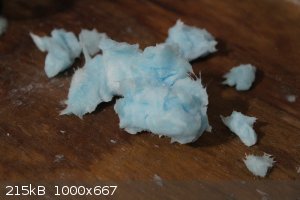
[Edited on 8-12-2022 by Hey Buddy]
I heated a sample of this NQ/Glycine experiment and it lost blue color in some areas and reverted to white needles and appears to not be a cocrystal
nor complex. It seems the blue was simply trapped between the crystal and the intermittent intensity increase in burning were concentrated holdings of
Glycine Cu ClO4.
[Edited on 8-12-2022 by Hey Buddy]
|
|
|
Laboratory of Liptakov
International Hazard
    
Posts: 1382
Registered: 2-9-2014
Location: Technion Haifa
Member Is Offline
Mood: old jew
|
|
Thanks, Buddy.....Interest experiments. ....The path to success, to goal, is always lined with rows of failures. A like trees along the way...
Development of primarily - secondary substances CHP (2015) Lithex (2022) Brightelite (2023) Nitrocelite and KC primer (2024)
|
|
|
Hey Buddy
Hazard to Others
  
Posts: 426
Registered: 3-11-2020
Location: Bushwhacker Country
Member Is Offline
|
|
Yes, failure is a good thing in pursuit of understanding. --Just today, I have learned by failing a NQ complex crystal change that the glycine
perchlorate is extremely reactive. It looks much more promising than guanidine moiety.-- I thought of using glycine after watching tetrazole lovers
video on glycinates. I found a paper on his website I have never read before which he doesnt really refer to very much, it is hidden and referenced in
comments on a video. The paper reveals a lot of data about amino acid ionic explosives. "Insensitive Ionic Bio-energetic Materials From Amino Acids".
These amino acid salts are not incorporating any metal ions just oxidizers alone. The simple glycine perchlorate is impact insensitive IS >60 FS
>360 and has a Vd of 8470 m/s and P of 32 GPa at 1.89 g/cc. That is already in the RDX range and the material has a melt shelf beginning at 103 C
and decomposing at 263 C.
There are other simple amino acid perchlorates which have lower melt shelfs. Alanine amino acid perchlorate melt shelf begins at 88 C. It is a lower
pressure 17.8 GPa but this is really incredible stuff. I am infatuated with it all morning.
The amino acid salts are very simple to make, temp stable. They seem like excellent field of test materials for SM energetic material enthusiasts. I
wonder why this has gone under the radar? They probably have simple melt casts. The simple glycine perchlorate is a slightly lower performance
comparable to theoretical "NTNT" but it is made in high yield and is cheaper.
[Edited on 8-12-2022 by Hey Buddy]
|
|
|
Laboratory of Liptakov
International Hazard
    
Posts: 1382
Registered: 2-9-2014
Location: Technion Haifa
Member Is Offline
Mood: old jew
|
|
I find old notes: Preparation Cu - Glycinate: 4.5g dry Glycine dissolved in 20g dH2O. Heated on 70C. 1g CuCO3 (dry) is prepared. Added in small
portions, 10x. CO2 get out. Boiled - heated 30 minute at 70 C. Cu-Glycinate arises directly at 70 C. At 20 C arise from solution solid - fluffy
material. For precipitation is necessary EtOH 50g. Filtered. Dry at 40 C. Yield: 4.38g Cu - glycinate as dry material x 1H2O.
Preparation Cu - Gly - perchlorate: 3.08g CuSO4x5H2O + 20g dH2O on 50 C. and 2.84g Cu-Gly x1H2O added as dry material. This is solution A.
4g BaClO4x0H2O + 30g dH2O heated also on 50C. This is solution B.
B pour into A.
Keep at 50 C 15 minute. Cooling on 20 C. Precipitat is BaSO4. Blue solution is Cu - Gly - ClO4. Drying process of solution o inert plate at 40C.
Material is extremly hygroscopic. Necessary fine neutralisation by NH4OH. After neutralisation is material no hygroscopic. At flame heating is see
energetic jets. Material burn only with support flame further. Conclusion Laboratory of Liptakov: Due to difficulty preparation and precursors and low
burning is not perspective energetic material for use as DDT. Much easily is use Cu(ClO4)2 + hexamine. Which is flamable easy, with easy DDT and
output pressure cca 28 GPa. Details in thread LL8.
Development of primarily - secondary substances CHP (2015) Lithex (2022) Brightelite (2023) Nitrocelite and KC primer (2024)
|
|
|
Hey Buddy
Hazard to Others
  
Posts: 426
Registered: 3-11-2020
Location: Bushwhacker Country
Member Is Offline
|
|
LL, did you know when you made it, it is proably 8400 m/s? Did you test melt point by chance? Glycne ClO4 melt is around 103 C. Id guess the copper
complex is in there closely. -- I read about barium precipitations. they are used in literature for difficult ClO3/4 complexes but I think in these
cases there are combinations of metal salts which allow complexation of the target ligand simply by adding it neutral along with metal salt with
perchlorate salt for double displacement piggy back. I suspect glycinates can be made easier this way.
Did you check any other metals besides Cu?
I think there are some easy to make or buy ligands that would be fun to try. in these types of complexes besides guandine or glycine. Allantoin comes
to mind. The nitrite cyclized azoles of common materials would be interesting too. You can add nitro groups to hydroxide and oxychains and cyclize
them to azoles or pyrroles in one shot with nitrite. Those could be higher nitrogen versions of these types of complexes but less nitrogen and
difficulty than tetrazoles. Like a easy/cheap version of tetrazole complex work flow.
[Edited on 8-12-2022 by Hey Buddy]
|
|
|
specialactivitieSK
Hazard to Self
 
Posts: 94
Registered: 21-10-2014
Member Is Offline
Mood: No Mood
|
|
Has anyone made dicyandiamide from calcium dicyanamide?
Need it for making guanidinum perchlorate from melting (150-160 °C) with ammonium perchlorate. Thx.
|
|
|